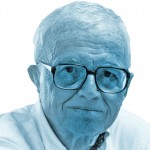
Last week, looking back on my first year as a blogger, I mentioned that the hardest column to write was the one that taught me the most. “No Second Act” (Feb. 4) was about the forgotten American writer John Horne Burns, whose World War II novel The Gallery, published in 1947 to great acclaim, made him briefly famous. Reading it then, I could hardly believe how closely Burns’s story paralleled my own coming of age as a young GI in North Africa and Italy. I still remember that gift with gratitude, and now I wanted to try to make sense of his short, disappointed life.
I had written about Burns once before, in 1990, when the Book-of-the-Month Club reissued The Gallery in a special edition and asked me to write a new introduction. Eager to give the members their money’s worth, I wrote a lengthy travel memoir and critical appraisal that I was quite pleased with. Now, for my blog, I thought I would just need to cut and reshape that earlier essay.
I found it in my files and began reading . . . and reading . . . and reading. The opening paragraph was followed by nine paragraphs–nine paragraphs!–describing my wonderment at being suddenly immersed in an Arab land unimaginably different from my Ivy League upbringing. Two entire paragraphs were devoted to the French architecture and Arab street life of Algiers.
As travel writing and as military history it was interesting stuff. Algiers in the spring of 1944 was a waiting room for the Allied invasion of southern France. “Probably,” I wrote, “no other wartime city had such a mixed wardrobe of Allied uniforms walking its streets: Americans, Britons, Australians, New Zealanders, Canadians, Free French, Free Poles, Brazilians, Gurkhas, Senegalese, and ‘Goums’–small, fierce-looking tribal warriors from France’s military outposts in the Sahara.”
But wasn’t that piece supposed to be about John Horne Burns, not about me? My only connection to Burns was that he wrote a book that helped me to process my own war. Now I realized that I had become the captive of my own life narrative. I would have to start from scratch. As writers, we all do. There’s no free lunch.
My first task was to squeeze all that preliminary material–my interest in Burns as a helpful figure in my life–into as few words as possible without squeezing it dry. That job took a dozen sentences:
In 1944 I was a 21-year-old army private, formerly a sheltered son of the Eastern establishment, suddenly deposited in Casablanca. I was in North Africa! Me! Nobody in my life had ever mentioned the Arabs. Our heritage was Europe; everything else was terra incognita.
The next day my fellow GIs and I were loaded onto a train of “forty-and-eights,” decrepit wooden boxcars first used by the French army in World War I to carry 40 men or eight horses. Eight horses would have been more comfortable. For six days I sat in the open door of that boxcar with my legs hanging out over Morocco, Algeria and Tunisia, a wide-eyed kid on a sensory high, intoxicated by new sights and sounds and smells. I loved the hubbub at the stations–Fez! Oujda! Sidi Bel-Abbes!–and I romanticized the Arabs themselves, even the skinny kids with beautiful smiles who ran alongside our train and pestered us for C rations and cigarettes.
Soon enough I would understand that the Arabs weren’t “picturesque.” They were a severely deprived people, many with skin and eye diseases that modern medicine knows how to cure. It was the beginning, if not of wisdom, at least of the knowledge that “abroad” is a complicated place, not reducible to travel-poster simplicities.
That wrapped it up for me; the rest was about Burns. It was a complicated story, with flashbacks and flash-forwards and many psychological levels. It could only be told if readers were fed chunks of information in the order they needed to understand the next chunk.
First. What wartime Naples was like: a brutally bombed and degraded city. Its emotional heart–the organizing motif of Burns’s book–was a huge arcade called the Galleria Umberto, a 24-hour hub of black-market buying and selling.
Next. Burns’s place in the literature of World War II. The early blockbuster books, like The Naked and the Dead, were novels of combat that didn’t speak to my experience. The Gallery did.
Next. Who Burns was: his earlier life as a private-school English teacher.
Next. The structure of The Gallery and its central theme: Burns’s gradual loss of innocence. How he came to hate the privileged arrogance of American soldiers and to love the destitute Italians, thereby anticipating by a generation the hubris of Vietnam and the idea of “the ugly American.”
Next. Burns’s postwar life: his bitterness over the critics’ savage reviews of his second novel and his decline into drink and early death.
Next: How The Gallery holds up today. How, rereading it, I saw–as I couldn’t have known in 1947–that it foreshadowed such World War II classics as The Caine Mutiny. Mister Roberts, Catch-22, and Naples ’44.
My essay, in short, was a composition exercise. I didn’t enjoy writing it, but I loved having written it. It’s airtight, I think, and it says in 1,000 words everything that really needs to be known about Burns and his legacy. It taught me to beware of the past as a launching pad for writing about the present. The past is often a trap.
——-

